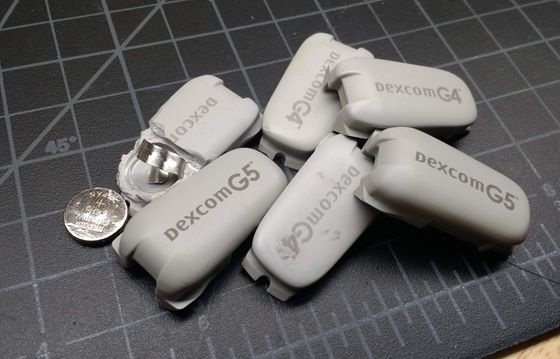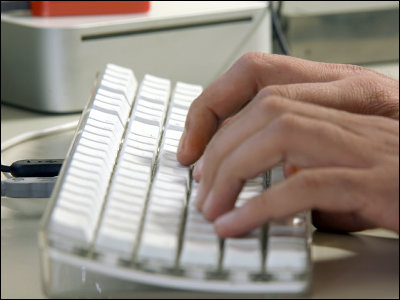It is technically difficult to constantly and constantly monitor human blood glucose levels

Daily measurement of blood sugar level is indispensable for treatment of diabetes which blood sugar level becomes abnormally high for some reason. For blood glucose measurement, CGM (Continuous Glucose Monitoring), which collects blood from the tip of the finger and measures the blood glucose level directly, uses a sensor attached to the arm or belly and constantly monitors the blood glucose level There is a method called blood glucose measurement). Although CGM is an indispensable device for some diabetic patients, Dan Maloney himself also suffers from diabetes, from various problems such as price, communication standards and specifications "It is not always possible to continuously monitor human blood glucose levels at all times It's difficult, "he says in Hackaday .
Why is Continuous Glucose Monitoring So Hard? | Hackaday
https://hackaday.com/2018/12/03/why-is-continuous-glucose-monitoring-so-hard/
Type 1 diabetes, the pancreas islet β cells in the will be destroyed by an autoimmune an inhibit hormone blood sugar insulin is a disease that secretion capability of remarkably lowered. Higher blood glucose levels put a burden on capillary vessels and kidneys, which can cause complications such as neuropathy, retinal injury, renal disorder. CGM is a very important instrument for patients with type 1 diabetes because people with type 1 diabetes need to measure blood glucose and accurately inject the required amount of insulin into the body accurately.
CGM consists mainly of three parts: a sensor that reads the glucose concentration in the interstitial fluid by piercing the subcutaneous tissue, a transmitter that transmits the read blood glucose value wirelessly, and a receiver that receives it. CGM has a big advantage that blood sugar level can be measured anytime anywhere by simply pinching the receiver over the sensor part adhered to the skin, unlike the type that requires a finger to be scratched with a needle at every measurement. Furthermore, by linking the receiver of CGM with "insulin pump", it is possible to construct "artificial pancreas".

by Intel Free Press
Ultra fine gold wires coated with glucose oxidase are used for sensors used in CGM. Glucose oxidase, a glucose degrading enzyme, degrades glucose to make gluconolactone and hydrogen peroxide. Measure the glucose concentration in the interstitial fluid from the current generated by this reaction.

by Alden Chadwick
However, this sensor can be attached to the body in about 1 to 2 weeks and it must be replaced according to the expiration date. Many people keep wearing the sensor ignoring the deadline in order to save the sensor, but if it is wearing for a long time, the immune system in the body will destroy glucose oxidase and it will be impossible to measure. In order to eliminate the expiration date of the sensor, it is necessary to develop a special coating that prevents the immune system from attacking glucose oxidase on the sensor.
In addition, the sensor must be set as a transmitter that digitizes the read signal and wirelessly transmits it to the receiver. However, if you adhere a sensor and transmitter built-in device to your skin for a long time, it may cause contact dermatitis and some side effects. Furthermore, the transmitter's battery is limited, so you can not keep the sensor on forever.

by Alden Chadwick
Also, there is almost no compatibility of the equipment within the manufacturer is also a big problem. Wireless system by transmitter also differs depending on the equipment, some use 2.4 Ghz ISM band , others by Bluetooth connection exist. As medical devices become more and more new with advances in technology, there is a possibility that even with old sensors attached, it is not possible to deal with new equipment.
Mr. Maloney tells me at least that I will just change the battery, but the sensor unit of CGM used by Mr. Maloney is sealed in a plastic capsule case by waterproof measures. Because it is impossible to open the capsule case without breaking it, he seems to have appeared on the net to make a hole in this capsule case and forge a battery to replace batteries.

Mr. Maloney said that it will charge as much as $ 75 (about 8500 yen) for one sensor for CGM. Looking at the exploded pictures and specifications on the Internet, although it can not be helped because it takes hundreds of billions of yen in research and development and clinical trials, "The price of 75 dollars feels rather expensive," said Maloney He says. If "complete CGM" that does not require exchange of sensors and transmitters is developed, the cost of treatment can be greatly reduced, but it seems to be still difficult due to technology limitations.
Maloney argues that "applying the RFID technology can make the transmitter very small and does not need to make it possible to change the battery." In fact, Google has announced that it is developing a Google contact lens that can measure blood sugar levels simply by wearing it. This means that you can monitor the blood sugar level by mounting a sensor on the surface of the contact lens and measuring the glucose concentration inside the tear. The fact that battery is not worried because it supplies power wirelessly was also a point to make great expectation for establishment of perfect CGM.

However, as a result of repeated research, Google announced the cancellation of the project in November 2018 as "we can not find a correlation between glucose concentration in tears and blood glucose level". Mr. Maloney who was paying attention to Google's project as a revolutionary CGM technology seems to have been largely discouraged by this news. Mr. Maloney said that someone expects to challenge the development of better CGM and strongly urges CGM manufacturers to lower the market price a little more.
In addition, a new type of CGM is announced at the annual meeting of American Diabetes Association held in June, 2018. This CGM says that the sensor is embedded in the arm rather than sticking it to the skin, and it can be used continuously for 180 days. It seems that you can send blood glucose values to smartphone, Apple Watch, etc. with Bluetooth.
Also, Google has canceled the blood glucose measurement project with smart contact lenses, but it is reported that Apple is working on a plan to install Apple Watch with the ability to measure blood glucose without damaging the skin. If this function is realized, it is considered to be useful for many diabetes patients including Mr. Maloney as a new blood glucose level management system replacing the conventional CGM.
A secret research team is running within Apple to bring innovation to diabetes treatment with Apple Watch - GIGAZINE

Related Posts:







